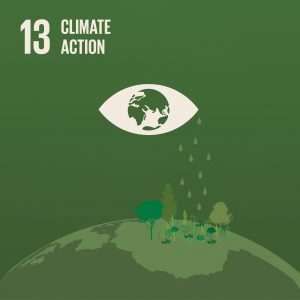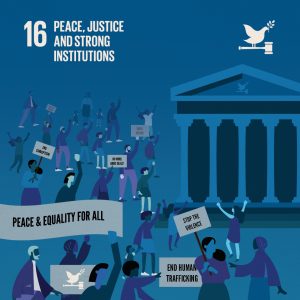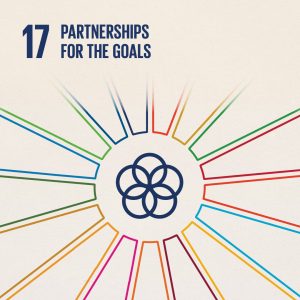By Sabrina De Los Santos Rodríguez
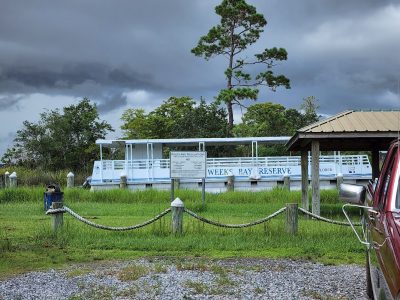
Dark clouds over the Week’s Bay boat. Photo credits: Sabrina De Los Santos Rodríguez
On Sunday, August 7th, 2022 I was on a white van with seven other people – all climate science graduate students and professors with diverse specialties. We were leading the route from Fairhope, Alabama to Biloxi, Mississippi with a minivan and an SUV filled with more students and professors following us. The outside of our van had a Geosciences logo from Auburn University. I felt like I was back in high school on a field trip, except with people I had just met in person for the first time. I had seen some of their faces on Zoom for the past two and a half years since the project started right when the world was on lockdown because of the pandemic. Chelsea [pseudonym], the 22-year-old graduate student sitting next to me was brand new to the program. She had finished her Meteorology bachelor’s degree that summer and had moved to Auburn, Alabama to study “Rural Sociology and Agricultural Economics.” As we were crossing a bridge past the exit featured on Forrest Gump, her eyes lit up and she waved her hands in front of her “Oh, look at that beautiful cloud! We are getting a big storm today. I’m so excited.” The cloud looked like a giant white fluffy bouncy castle. The kind you want to float on. I asked her how she knew a storm was coming by looking at that cloud. She explained the stages of how thunderstorms form. How puffy cumulus clouds form in the atmosphere when warm, moist air moves upward and how the cloud starts to look dark and gray as more water is added to it. Eventually, the air moving within the clouds build up electric charges, which forms lightning. Listening to her and starring out the window, I had a flashback to my flight here from Boston. A kid around 9 years old was sitting behind me with his dad. They had the most intriguing and imaginative conversations. I could see the boy’s small hands in the tiny space between my seat and the window we shared, pointing to the clouds saying, “I’ve always dreamt of living on a cloud and jumping from one to another. These clouds look so soft and fluffy. I wonder what they feel like.” I smiled with nostalgia since I had the same thoughts as a child. I think most of us did. I secretly still look at the clouds finding shapes and dreaming of using them as trampolines, feeling light and airy. Until that moment, I hadn’t thought of fluffy clouds as a sign of a storm.
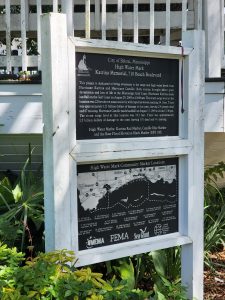
Hurricane Katrina memorial. Photo credits: Sabrina De Los Santos Rodríguez
As we moved through Ocean Springs, Mississippi and stopped at different spots in Biloxi affected by Hurricane Katrina, the clouds got darker and less fluffy. We saw a faint lighting strike and Chelsea’s body shook once again with excitement, “Lightning! I love this. I’ve been looking forward to this trip for months.” Professor Tom sitting at the front of the van, was guiding us on the trip and started explaining lightning with scientific terms I had never heard of before. I asked questions fascinated by their eagerness to explain to me things I had never understood about climate. As much as we study the weather as children, I think it stays as a magical unpredictable series of events for most of us. Most of us bring up the weather at work and when talking to strangers, “Ugh. It’s muggy out today. It’s so hot I can’t stand being outside. It’s raining and perfect for a nap. It’s a beautiful day for a walk.” If you live in the Northeast or anywhere where the weather patterns change drastically from day to day and within 24 hours, you are always looking at your weather app, deciding what layers of clothing to bring with you. We get annoyed by the weather, complain about the changes, and constantly throw in the word “climate change” as an explanation to any event that seems abnormal. Some of us get frustrated by the daily weather small talk before diving into our meeting topics or starting to get to know each other more deeply.
I’ve always been fascinated by the weather. One of my first memories as a child was when Hugo, a borderline category 3-4 hurricane landed in Puerto Rico in 1989. I was only 2 years old at the time, so my parents are still skeptical I remember anything but their stories about the hurricane. Somehow, I can visualize my parents moving their mattress to our tight hallway away from the windows. Our screen and front door were rattling from the 160 mph wind gusts as the three of us slept together. I remember the house was completely dark and some leaves and a bit of water started coming in from under the door, but I felt safe in between my parents’ arms. In a strange way, it has always been one of my favorite memories as a family. Nine years later, I experienced Hurricane Georges (category 4) when I was in the 6th grade and old enough to remember the devastation. We lost electricity and water for weeks. Our neighbors in our apartment complex gathered outside every day after the hurricane bringing out all the meat from their freezers to cook it in portable gas stoves before it spoiled. The adults talked about destruction, politics, and getting back to work and school eventually. The kids ran around jumping from one fallen tree to another, picking up leaves from the sidewalks that had cracked and lifted. We made new friends and rejoiced at not having school for a couple of weeks. We had to shower with cold water our parents had collected in buckets before we lost access. As a child, hurricanes meant eating Chef Boyardee and Vienna sausages once we were out of fresh food; painting with a flashlight in the evenings; listening to news updates on my parents’ small antenna radio; and going to school without our uniform because we couldn’t waste water washing our clothes.
Looking back now, hurricanes meant significant changes, getting creative and unifying as a community. They were loss and trauma for many. As we stood in the scorching sun at the Hurricane Katrina Memorial, reading through the long list of lives lost and families changed forever on August 29, 2005, I started to feel my heart palpitating faster with sadness. On the left side of the memorial there is a pole with blue, yellow and red markings. The red marks at 22 feet high, indicate the level of water above mean sea level during the storm surge over 17 years ago. Professor Tom showed us images of all the spots we visited before and after the hurricane. Most were unrecognizable. The city had slowly restored the coast with casinos, hotels, restaurants, and a Ferris wheel with the hopes of bringing tourism and improving the economy. None of these structures existed before the hurricane. Instead, the area was densely packed with homes that mostly got destroyed and were unreachable by other communities when the bridge connecting Biloxi and Ocean Springs, Mississippi collapsed. We went through a neighborhood where many Vietnamese families lived that had only a few houses restored, some on stilts because of the building standards set after the hurricane, and some built on the ground too soon before the standards were settled. You can still see many empty lots with gravel indicating what used to be the entrance to someone’s garage. Families taken from their homes, forced to move somewhere else they could afford. Ghost houses in between new fences put up by families who could afford to rebuild. The predominantly African American neighborhood, despite being of similar socio-economic background had more houses than the Vietnamese community. You could see more life on their streets. Kids playing in their front yards and adults taking out the trash. Moving unto the predominantly White neighborhood, also with a similar working-class economy, it felt as if winds and water had barely touched their area. Their houses looked restored, and their gardens were thriving. Prejudice, racism, language barriers and economic burdens were evident as we drove past these three adjacent neighborhoods.
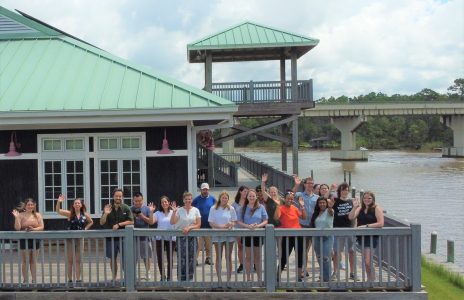
The 2022 immersion experience group with Sabrina pictured. Photo credits: Kathryn Brown
On our way back to our Week’s Bay research dorms in Fairhope, AL, the rainstorm started to pick up and eventually became a heavy thunderstorm. The thunderstorms in Fairhope feel stronger than anything I have ever experienced. They wake you up in the middle of the night, your bed shaking, and your ears confused with the roar of a lightning strike that seems to land right next to your window. This trip was part of a five-day immersion experience for graduate-school trainees who had received an award as part of the Auburn University National Science Foundation (NSF) Research Traineeship (NRT) program. The NRT program aims to train the next generation of scientists and leaders who can help build resilient communities that are prepared for, can effectively respond to, and quickly recover from damaging hazard events in the southeastern United States. MS and PhD students conduct research within an integrated and multidisciplinary framework with the aim to better understand, predict, and communicate the resilience of natural, social, and built environmental systems. Students accepted into the traineeship are assigned to a new cohort each year. The Earth (2020), Wind (2021) and Fire cohorts (2022) participated in this immersion experience whether virtually or in-person. Throughout the week, we heard from speakers with backgrounds in geology, meteorology, science education, and marine biology. Auburn University professors who belong to the NRT project, presented their work and gave a snapshot of the graduate courses students were required to take to complete their traineeship. Graduate students from the first two Auburn NRT cohorts (Earth and Wind Cohorts) presented their research projects, summarizing their interests, passions, and backgrounds. All students made connections with peers and experts in their fields.
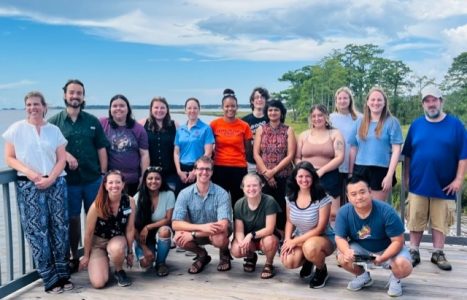
The 2022 immersion trip group. Photo credits: Sabrina De Los Santos Rodríguez
I spent those five days staying with the Wind and Fire cohorts in the research dorms, hearing stories of how they got interested in climate science, getting recommendations on how to improve the fellowship activities and mentorship components, and laughing at their mischievous childhood memories. As an evaluator and non-expert in this topic, this experience gave me a deeper appreciation for climate science, and the incredible work these scientists are doing to create sustainable climate resilience solutions. The next time someone brings up the weather as a form of saying hello, I will be thinking of this memorable trip, the excitement of scientists who dedicate their lives to climate, how day-to-day weather influences long-term climate change, and how natural events can shape communities for centuries.
Sabrina De Los Santos Rodríguez is a TERC Research Associate and Evaluator.
Learn about the SDGs & AU and our contributions related to this post.

